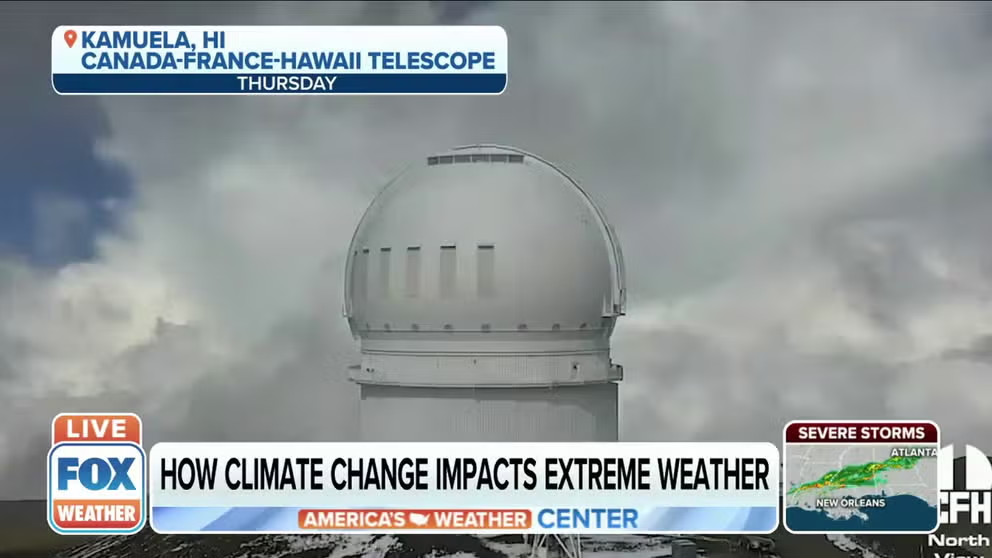Atmospheric carbon dioxide levels at 4-million-year high; El Nino could boost numbers in 2023, WMO says
The World Meteorological Organization released the latest Greenhouse Gas Bulletin and found that levels of carbon dioxide are similar to those found 3 to 5 million years ago when major coastal cities in the U.S. were underwater. The growth wasn't as dramatic as expected and scientists feel it was La Nina and 2023 could bring about the correction.
How climate change impacts extreme weather
Katharine Hayhoe, a climate scientist, talks how climate change impacts extreme weather.
GENEVA – Earth's atmosphere hit a 3 to 5-million-year high for carbon dioxide concentration, a greenhouse gas, according to the World Meteorological Organization's new Greenhouse Gas Bulletin, and concentrations could grow rapidly in 2023 with El Niño.
"The last time the Earth experienced a comparable concentration of CO2 was 3-5 million years ago when the temperature was 2-3°C warmer (3.6 to 5.4 degrees F) and sea level was 10-20 meters (32.8 to 65.6 feet) higher than now," the WMO said in a statement.
Carbon dioxide levels increased in 2022 but not as much as anticipated; Scientists point to La Niña
The WMO said that levels in 2022 were 50% greater than in the pre-industrial era and will continue to grow in 2023. And the annual increase in the amount in 2022 was smaller than the increase from 2020 to 2021 for the last decade. Concentrations increased by 2.2 parts per million, while the previous decade saw a 2.46 ppm growth every year.
RISING SEA LEVELS TO FLOOD NEARLY 650,000 OCEANFRONT PROPERTIES ACROSS US BY 2050, STUDY FINDS

File: The first image from Meteosat Third Generation – Imager 1 (MTG-I1) reveals a level of detail about the weather over Europe and Africa not previously possible from 36 000 km above Earth. The higher-resolution images provided by the instruments on board give weather forecasters more information about the clouds cloaking much of Europe and visible in the equatorial region of Africa and the Atlantic Ocean. Sand and sediment in the waters off Italy are also visible, as well as dust or smog being carried from South Asia.
(EUMETSAT/ESA / NASA)
"The most likely reason is increased absorption of atmospheric CO2 by terrestrial ecosystems and the ocean after several years with a La Niña event," said the WMO, setting the stage for a large increase in 2023. "The development of an El Niño event in 2023 may, therefore, have consequences for greenhouse gas concentrations."
Odds for a super El Nino, a "historically strong" event according to NOAA, are increasing.
Methane and nitrous oxide, the second and third main greenhouse gases, saw their highest year-over-year increase on record from 2021 to 2022, said the WMO.
EL NINO'S ODDS FOR ‘HISTORICALLY STRONG’ EVENT INCREASE; COULD LINGER THROUGH SPRING
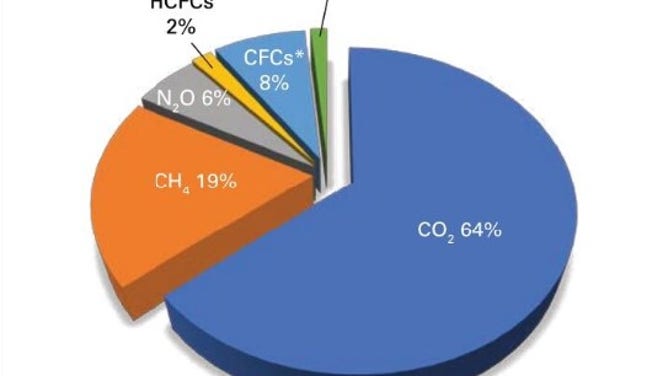
Contribution of the most important long-lived gases to the increase in global radiative forcing from the pre-industrial era to 2022.
(WMO / FOX Weather)
What was the Earth like 3 to 5 million years ago, and why did the warmth stop?
That was the Pliocene Epoch, where animals lived several hundred miles north of where their offspring live now. Less polar ice accounted for the higher sea level. According to the University of California Museum of Paleontology, the sea level could have been as much as 98 feet higher at the epoch's warmest.
"Long before the Pliocene, CO2 levels were extremely elevated during the age of the dinosaurs (which ended 65 million years ago), perhaps at some 2,000 to 4,000 ppm," reported Mashable. "Tremendous CO2 emissions, from incessant and extreme volcanism, heated Earth and allowed dinosaurs to roam a sultry Antarctic."
NERVOUS GRINDAVIK RESIDENTS QUICKLY RETURN TO DANGER ZONE AMID FEARS OF VOLCANIC ERUPTION IN ICELAND
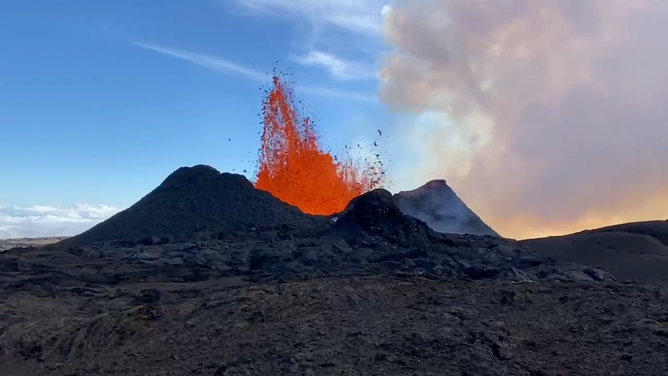
File: An image showing lava from an active fissure on Hawaii's Mauna Loa volcano spewing blebs of liquid rock into the air.
(@USGSVolcanoes/Twitter / FOX Weather)
Eventually, rocks absorbed carbon dioxide from the atmosphere, which lowered levels to the 400 ppm level. According to NOAA, Earth continued to lock up the greenhouse gas into the Pleistocene Epoch until levels stabilized around 280 ppm or less. That's where levels remained through to the Industrial Revolution in the mid-1700s.
"The Pliocene contains what might be the closest analog to climate conditions expected in the near future, and therefore understanding the Pliocene is not only of academic interest but essential for human adaptation," stated Britannica.com.
A cooling and drying trend marked the end of the Pliocene. The Mediterranean Sea dried up and became grasslands and plains for the next several million years, according to the museum.
CLIMATE CHANGE IMPACTS COSTING US $150 BILLION A YEAR, GOVERNMENT REPORT SAYS

File: The present day Mediterranean off of Greece.
(Nicolas Economou / NurPhoto / Getty Images)
"It is uncertain what caused this cooling of the climate from the beginning to the end of the Pliocene period," states the museum. "Changes in the amount of heat transported by oceans has been suggested as one possible explanation; higher concentrations of greenhouse gases in the atmosphere may also have contributed."
The epoch ended about 2.6 million years ago when a series of supernovae bathed the Earth in radioactivity, leading to a mass extinction, theorized researchers in a study. Earth moved into the Pleistocene, marked by ice ages, then.
Scientists struggling with unknown climate change drivers
While the WMO states they understand broad strokes of climate change, they detailed several unknowns about the carbon cycle.
MAGIC MUSHROOMS: SCIENTIST SAYS FUNGI COULD REVOLUTIONIZE CLIMATE CHANGE FIGHT
The Greenhouse Gas Bulletin cites "challenges" to understanding the drivers of climate change:
- Feedback Mechanisms: The Earth's climate system has multiple feedback loops, for example, increased carbon emissions from soils or decreased carbon uptake by oceans due to changing climate, as illustrated for Europe for the droughts in 2018 and 2022.
ANTARCTICA'S ‘DOOMSDAY GLACIER’ IS MELTING AWAY DIFFERENTLY THAN SCIENTISTS FIRST THOUGHT
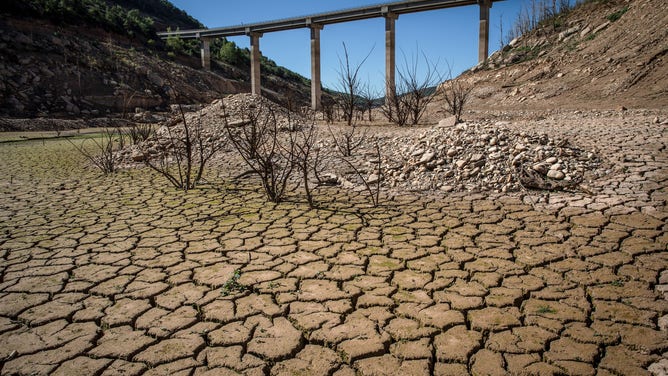
File: Cracked earth on the exposed bed of the Rialb reservoir during a drought in La Baronia De Rialb, Spain, on Tuesday, Aug. 23, 2022. Europe is currently in the throes of a drought that appears to be the worst in at least 500 years, according to a preliminary analysis by experts from the European Unions Joint Research Center.
(Angel Garcia/Bloomberg / Getty Images)
- Tipping Points: The climate system may be close to so-called "tipping points", where a certain level of change leads to a self-accelerating and potentially irreversible cascade of changes. Examples would include the potential rapid die-back of the Amazon rainforest, slowing of the northern ocean circulation or the destabilization of large ice sheets;
SCIENTISTS FEAR HEAT, DROUGHT KILLED AT LEAST 120 RARE DOLPHINS IN AMAZON
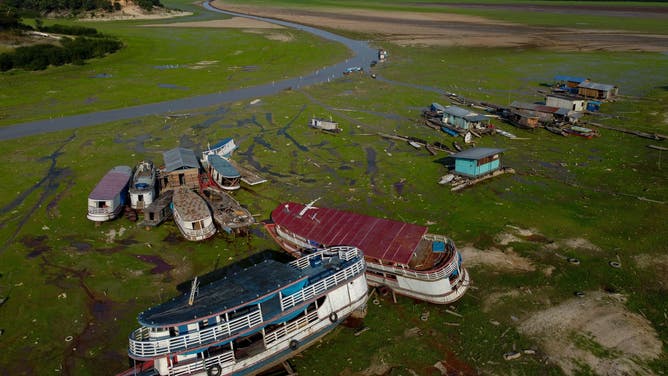
File: In this aerial view, boats are seen stranded in Aleixo Lake due to the severe drought west of Manaus, Amazonas State, on September 29, 2023. Manaus City Hall declared a state of emergency due to the current drought, which is already one of the worst on record.
(MICHAEL DANTAS/AFP / Getty Images)
- Natural Variability: The major three greenhouse gases have substantial variability driven by natural processes superimposed on anthropogenic signals (e.g., driven by El Niño). This variability can either amplify or dampen observed changes over short timeframes.
- Non-CO₂ Greenhouse Gases: Climate change is driven by multiple greenhouse gases, not just CO2. These gases have different atmospheric lifetimes, greater Global Warming Potential (GWP) than CO2 and uncertain future emissions.
Greenhouse Gases
NOAA's Annual Greenhouse Gas Index shows that the long-lived gases increased their warming effect by 49% from 1990 to 2022. Carbon dioxide accounted for 78% of the increase and about 64% of the warming. The WMO blames fossil fuel combustion and cement production largely for the gas ramp-up.
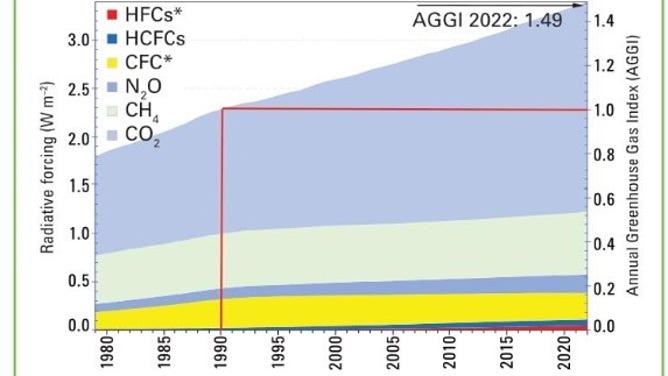
Atmospheric radiative forcing (warming effect) relative to 1990, by main greenhouse gasses corresponding to the 2022 update of NOAA's Annual Greenhouse Gas Index.
(WMO / NOAA)
"Just under half of CO2 emissions remain in the atmosphere. Just over one quarter are absorbed by the ocean and just under 30% by land ecosystems like forests – although there is considerable year-to-year variability in this," stated the WMO. "As long as emissions continue, CO2 will continue accumulating in the atmosphere, leading to global temperature rise. Given the long life of CO2, the temperature level already observed will persist for several decades even if emissions are rapidly reduced to net zero."
Methane accounts for about 16% of the warming effect and stays in the atmosphere for a decade, per the WMO. About 40% comes from natural sources, while the rest is man-made through farming, livestock, landfills, burning etc.
Nitrous Oxide accounts for about 7% of the warming, said the WMO. About 60% of it comes from natural sources.
The United Nations aims to limit global warming to 1.5 degrees C above pre-industrial levels and "well below 2 degrees C" following the Paris Agreement.
